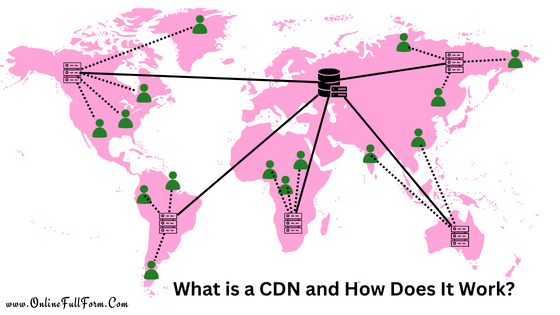On this page, We are going to learn about the full form of CDN and the meaning of CDN, As well as the meaning, definition, abbreviation, and acronym for CDN in different categories. So you should read this post till the end.
The Full Form of CDN: Content Delivery Network
CDN stands for Content Delivery Network. A CDN is a system of distributed servers that delivers web content to users. When a user requests a web page, the CDN server closest to the user will deliver the content. This reduces the load on the main server and improves the user experience.
It helps to minimize delays in loading web page content When the page is requested by the user, the content is dynamically recognized and delivered from the nearest server to the users, making fast delivery possible.
How Does Content Delivery Network Work?
Users access web content via a content delivery network (CDN), which is made up of a distributed system of servers. Content is cached on servers located near the users who are requesting it, which speeds up the delivery of the content.

CDNs work by serving static content from a network of servers around the world. Content will be delivered from the nearest CDN server to a user when they request a page. This reduces the load on the main server and speeds up the delivery of the content.
The benefit of Using CDN
A content delivery network (CDN) can speed up the delivery of your website’s content to your users. A CDN caches your website’s content on servers located around the globe.
When a user requests content from your website, the CDN delivers the content from the server that is closest to the user, resulting in a faster-loading website. The following are some benefits of using a CDN:
- Improves the performance and security of website or blog
- Prevents bots attack
- Monitors unusual activity
- Improves site performance
- Prevents Server Crash
- Improves SEO score, due to which your website ranks quickly
- The faster loading time of a website or blog
- Improved user experience
- Reduced bandwidth costs
- Improved website security
Types of Content Delivery Networks
There are a few different types of content delivery networks (CDN).
- Pull CDN – With a pull CDN, the website owner downloads the content from the CDN.
- Push CDN – With a push CDN, the CDN provider sends the content to the website owner.
- Hybrid CDN – With a hybrid CDN, the website owner downloads some content from the CDN, and the CDN provider sends some content to the website owner.
- Global CDN- With a global CDN, the website owner can cache content in multiple locations around the world. This type of CDN is ideal for websites that have a global audience.
How to Choose the best Content Delivery Network
Content delivery networks (CDNs) are a popular choice, but there are a few things to keep in mind when choosing one. How big is your audience? How much traffic do you expect? Where is your audience located?
A CDN is especially useful for large websites with global audiences. CDNs can help distribute traffic more evenly, which can improve the performance of your site if it receives a lot of traffic.
It is important to compare the pricing and features of CDNs before making a decision. Before choosing a CDN, try a few out for free. Some CDNs offer a free trial, so it’s worth trying a few out.
Now you might have got some ideas about the abbreviation, acronym, full form, and meaning of CDN. Also all popular full forms, acronyms, abbreviations, and CDN meanings and definitions.
